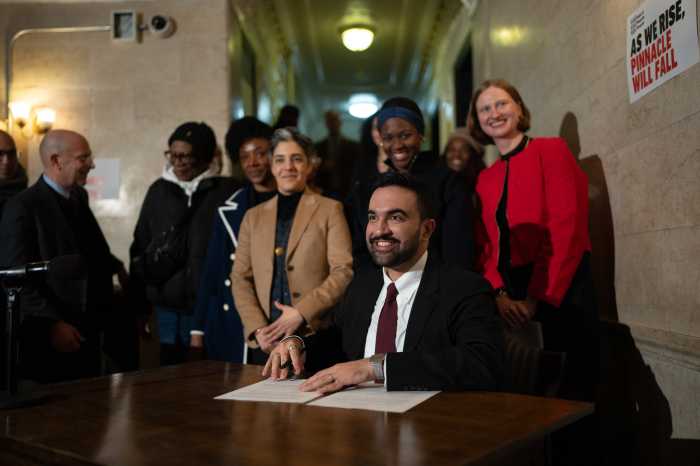The majority of the Queens Borough Board voted in favor — with the exception of one community board chair — to adopt the city’s Zoning for Coastal Flood Resiliency (ZCFR) text amendment, which would make permanent some building standards that would increase resilience to climate change in coastal areas.
The board, which includes the chairs of all 14 community boards, voted to pass the text amendment 13-1 with some recommendations during their first meeting of 2021, hosted virtually by Queens Borough President Donovan Richards on Monday, Jan. 11. City Council members Peter Koo, Barry Grodenchick, Adrienne Adams, Paul Vallone and Robert Holden also voted in favor of the text amendment.
Community Board 14 Chair Dolores Orr was the sole “no,” citing issue with the way ZCFR defines “vulnerable populations.”
The ZCFR plan is part of the city’s continuing efforts to rebuild as well as promote new and more resilient structures, particularly for those in low-lying areas, following Hurricane Sandy. Existing city zoning laws made it harder for storm-damaged properties and buildings to make needed changes after the superstorm, such as more elevated structures. In 2013 and 2015, zoning amendments passed to address those obstacles on a temporary basis.
Since the 2015 Recovery Text expired in 2020, the city is looking to make those changes permanent.
The proposal would allow homeowners, business owners, architects and others to design resilient buildings that are not just better protected from flood risks, but also reduce flood insurance costs. It would also set a framework for emergency situations, whether it’s another hurricane or COVID-19.
Alexis Wheeler, deputy director for City Planning’s Queens office, said the citywide text amendment has been updated throughout the years in coordination with community members and other city agencies.
“These provisions look to better protect all of us in the reality of climate change,” Wheeler said. “ZCFR was shaped by very real lessons learned on the ground with the impacted communities after Hurricane Sandy and furthered by analysis of resilient construction practices in the floodplain. The final proposal’s intention is to improve upon the temporary resiliency measures that have already been implemented and to make them permanent in order to promote long-term resiliency across the city and to help support coastal disaster recovery.”
The Borough Board vote comes a few months after each community board had the chance to discuss and vote on the plan with their board members and make recommendations.
But Orr, who represents the Rockaways, was concerned the plan’s definition of “vulnerable populations” only lists nursing home residents. Orr said the definition should be expanded to include adult home residents, assisted living residents, group homes residents and homeless shelter residents.
“Those populations are as vulnerable as just the nursing homes during the catastrophe of a major flood,” said Orr. “Our board supports [the plan] overall. Overall, you did a tremendous job.”
Orr added that bringing “additional senior populations” to floodplains throughout the city is “not a wise move.”
“We therefore ask that any new senior housing built in New York City that is in the 1 percent annual floodplain, that that new housing only be occupied by current residents of the community board, that we do not bring additional seniors into this floodplain,” said Orr.
Orr concluded that there should also be a review of existing roadways and their capacity to be used in the event of an evacuation.
Wheeler responded that they’re particularly thinking about people under nursing care at this time.
“In those cases, the process of moving many of the people who are in the midst of some form of nursing care […] oftentimes suffer significantly from the process of being moved,” said Wheeler. “The other categories of vulnerable populations, where people are still relatively independent of their living, would be able to either safely shelter in place if they’re in a resilient building or be able to sustain the process of evacuation more effectively. We really do distinguish between those two different types of vulnerable populations here, and so that’s part of why we think that long-term care facilities in particular are really the ones that are more critical to be calling out.”
The advisory board had several recommendations for the zoning text amendment, including reducing or eliminating ground floor use restrictions and creating subsidized and forgivable loans to property owners who must comply with the new regulations.
Some board chairs also presented questions about cellar space, landmark buildings and accessibility measures for seniors, like ramps. For the most part, the ZCFR plan allows for those amenities with some modifications, according to city planning officials.
“I think this text amendment will be helpful in achieving the goals, although this is not the end of what we need to do to ensure that Queens is greener and more sustainable and resilient,” said Richards. “There’s still a lot more that needs to be done, there’s no magic bullet that fixes everything with this text amendment. But just as we did in 2013 and 2015, and now, we continue to expand and build on it.”



































